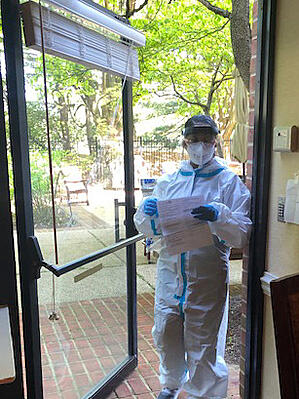COVID-19 is impacting everyone, but certain communities are at much higher risk for poor health outcomes and economic displacement than others.

Older adults (65+) are at higher risk for COVID-19,1 and data suggests that chronic health conditions such as diabetes and hypertension are linked with COVID-19 related risks and complications.2 As more data is published by states, we see that COVID-19 comorbidity is not only linked with chronic health conditions, but also a multitude of behavioral, economic, and social factors. Most notably, COVID-19 comorbidity is linked to population density, which significantly increases the likelihood of close contact between individuals.3
 Evidence suggests that the pandemic disproportionately affects communities of color.2 Racial data shows that Black American deaths are up to four times higher in some major cities, while Hispanics and Latinx make up most of the confirmed cases despite making up a minority of the population.4 A multitude of factors contribute to the disproportionate burden of illness placed on these communities, including but not limited to a higher rate of congregated living conditions, essential worker status, and reduced access to care.5 In fact, Hispanics/Latinx and Black Americans are two to three times more likely to be uninsured.5 Similarly, undocumented immigrants are vulnerable a heightened COVID-19 risk. The pandemic has revealed that not only do they make up a significant portion of essential workers, increasing the likelihood of their exposure, but they are also less likely to engage with community resources and health centers to seek clinical aid.6
Evidence suggests that the pandemic disproportionately affects communities of color.2 Racial data shows that Black American deaths are up to four times higher in some major cities, while Hispanics and Latinx make up most of the confirmed cases despite making up a minority of the population.4 A multitude of factors contribute to the disproportionate burden of illness placed on these communities, including but not limited to a higher rate of congregated living conditions, essential worker status, and reduced access to care.5 In fact, Hispanics/Latinx and Black Americans are two to three times more likely to be uninsured.5 Similarly, undocumented immigrants are vulnerable a heightened COVID-19 risk. The pandemic has revealed that not only do they make up a significant portion of essential workers, increasing the likelihood of their exposure, but they are also less likely to engage with community resources and health centers to seek clinical aid.6
Stories from COVID-19 teams on the field in Maryland have reiterated the unique needs of vulnerable communities during the pandemic. One family’s relative was admitted to a nearby hospital for COVID-19 and was initially unable to coordinate their discharge or understand the safety measures that had to be observed due to language barriers. Fortunately, the state dispatched response teams with language capabilities who were later able to connect the family, the hospital’s financial assistance department and social workers to coordinate the next steps.7
With states reopening and relaxing social distancing restrictions we have already begun to see resurgences and a rise in cases. Therefore, it is critical that we anticipate the pandemic’s collateral damage in vulnerable communities and coordinate response efforts accordingly.
There are three key provisions to keep in mind as states continue to develop their long term and sustainable COVID-19 efforts for vulnerable populations:
1. Targeted
Vulnerable communities will require a targeted response to cater to their unique needs. Most of the confirmed cases are from densely populated cities with a large minority and people of color population1, and the social health guidelines outlined by the CDC can be constraining factors for these communities. Many of these communities exist in congregated or multigenerational housing settings5 or are essential workers who are unable to work from home and are therefore unable to follow social distancing guidelines. Targeted educational resources that take into consideration language and cultural differences – as well as recognition of the historical distrust of health systems in some communities—are needed to uphold public health measures effectively. COVID-19 response efforts need to take these additional variables into account.
2. Holistic
Vulnerable communities will have non-COVID-19 related clinical needs. At-risk groups have clinically proven underlying health conditions that need to be understood. For example, Black Americans are at higher risk for chronic disease prevalence and morbidity.4 Systemic and systematic inequalities have contributed to clinical disparities, like chronic health disease prevalence, and have contributed to non-clinical inequities, including food insecurity, interpersonal violence, economic hardships , and more. Thus, response efforts should be holistic and well equipped to target both the clinical and non-clinical needs of residents. In one instance, COVID-19 response teams deployed in Maryland identified residents at shelters who were not regularly eating and had underlying health concerns. The teams connected these residents with the facility director to set up follow up appointments and arrange food deliveries through MANNA.7 Generally, vulnerable populations are supported by multiple resources through their communities, health agencies, and private organizations. However, during the COVID-19 response, it is possible that additional needs might be identified, which could ultimately exacerbate poor outcomes during the COVID-19 pandemic if not accounted for. Anticipating these needs and planning accordingly will be invaluable for long-term post COVID-19 recovery.
3. Mobile
In many (if not most) instances, members of vulnerable communities are unable to commute to the nearest clinic, hospital, or drive-by COVID-19 testing centers.5 The inability to access testing sites renders the traditional COVID-19 testing process ineffective. If these communities cannot make it to sites where testing is offered, then thousands of vulnerable groups will remain unaccounted for. COVID-19 testing efforts for these communities need to be mobile so individuals can be tested where they live or at convenient local sites where social distancing can be maintained.
The pandemic magnifies the fact that our vulnerable communities are the most unprotected and susceptible during times of crisis. A coordinated effort between the government, local health officials, and community members is necessary to adequately meet the needs of vulnerable communities during the coronavirus pandemic.
Watch our webinar, The New Normal: COVID-19 Solutions for the Present and Future, to learn more
Blog authored by former Array strategic planner, Anushka Choudhary.
Sources
- The Washington Post, “How the coronavirus exposed health disparities in communities of color.”, May 26, 2020.
- CDC, “COVID-19 Guidance for Older Adults”, 2020.
- Scientific America, “Are Crowded Cities the Reason for the COVID-19 Pandemic”, April 17, 2020.
- NPR, “What Do Coronavirus Racial Disparities Look Like State By State?”, May 30, 2020.
- CDC, “COVID-19 in Racial and Ethnic Minority Groups”, 2020.
- TIME, “’We’re Ignored Completely.’ Amid the Pandemic, Undocumented Immigrants Are Essential But Exposed”, April 17, 2020
- Maryland COVID-19 Response Taskforce, 2020.


